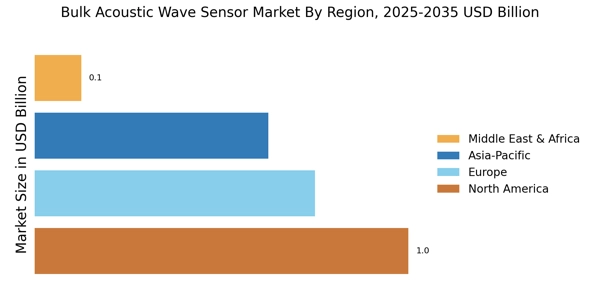Emergence of Smart Manufacturing
The emergence of smart manufacturing is a notable driver for the Bulk Acoustic Wave Sensor Market. As industries adopt automation and data-driven processes, the need for precise and reliable sensors becomes increasingly critical. Bulk Acoustic Wave sensors are integral to smart manufacturing systems, providing essential data for process optimization and quality control. The smart manufacturing market is projected to grow significantly, with investments in Industry 4.0 technologies driving this trend. As manufacturers seek to enhance operational efficiency and reduce costs, the adoption of Bulk Acoustic Wave sensors is likely to increase, thereby contributing to the overall growth of the market.
Growth in Automotive Applications
The growth in automotive applications serves as a crucial driver for the Bulk Acoustic Wave Sensor Market. With the automotive sector increasingly focusing on safety, efficiency, and automation, the demand for advanced sensing technologies is on the rise. Bulk Acoustic Wave sensors are being integrated into various automotive systems, including tire pressure monitoring and environmental sensing, to enhance vehicle performance and safety. The automotive market is projected to reach approximately 3 trillion USD by 2025, indicating a substantial opportunity for sensor manufacturers. As the industry continues to evolve towards electric and autonomous vehicles, the role of Bulk Acoustic Wave sensors is expected to expand, further driving market growth.
Advancements in Medical Diagnostics
Advancements in medical diagnostics represent a significant driver for the Bulk Acoustic Wave Sensor Market. The healthcare sector is increasingly adopting innovative technologies to improve patient outcomes and streamline processes. Bulk Acoustic Wave sensors are being utilized in various diagnostic applications, including biosensing and disease detection, due to their high precision and rapid response times. The global market for medical diagnostics is expected to exceed 500 billion USD by 2025, highlighting the potential for growth in this sector. As healthcare providers seek to enhance diagnostic accuracy and efficiency, the demand for these sensors is likely to rise, thereby contributing to the expansion of the Bulk Acoustic Wave Sensor Market.
Rising Demand for Consumer Electronics
The increasing demand for consumer electronics is a pivotal driver for the Bulk Acoustic Wave Sensor Market. As devices such as smartphones, tablets, and wearables become more prevalent, the need for advanced sensors that can provide accurate measurements and enhance functionality is paramount. The market for consumer electronics is projected to reach approximately 1 trillion USD by 2025, indicating a robust growth trajectory. This surge in demand necessitates the integration of Bulk Acoustic Wave sensors, which offer high sensitivity and reliability, thereby enhancing the performance of electronic devices. Furthermore, as manufacturers strive to differentiate their products, the incorporation of these sensors is likely to become a standard feature, further propelling the market forward.
Increasing Focus on Environmental Monitoring
The increasing focus on environmental monitoring is a significant driver for the Bulk Acoustic Wave Sensor Market. As concerns regarding air and water quality rise, there is a growing need for reliable sensors that can provide real-time data on environmental conditions. Bulk Acoustic Wave sensors are well-suited for this purpose, offering high sensitivity and the ability to detect a wide range of pollutants. The environmental monitoring market is anticipated to grow substantially, with investments in smart city initiatives and regulatory frameworks driving demand. This trend suggests that the Bulk Acoustic Wave Sensor Market will benefit from the heightened emphasis on sustainability and environmental protection.
















Leave a Comment